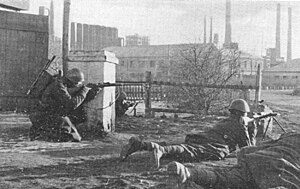Battle of Safashar (1951)
The Battle of Safashar, also known as the Siege of Safashar, was the final major battle of the Domlandian Civil War and is viewed by some historians as the end of the Domlandian Wars of Independence, although many Biggonian historians dispute this. The battle was fought in Safashar, the last major stronghold of the Eastern Biggonia Alliance (EBA) and capital of Khorrambid Prefecture. The battle lasted from early September to mid December, with Domlandian authorities declaring the city cleared of Biggonian fighters on the 13th December and the EBA leadership officially announcing the city as having fallen on the 17th December.
Opposing Forces
Domlandian Republic
Despite incurring substantial losses during the preceding Civil War, by September 1951 the Domlandian Army had reached a new height of strength, especially in terms of material quality and logistical capacity. In fighting immediately outside Safashar during Domlandian efforts to encircle the city, the Domlandian Republic committed 9 divisions, of which several were under full strength, with the final total approximately 60,000 men. Once Domlandia began to advance into Safashar proper, they had assembled a force of 12 divisions, titled the 3rd Domlandian Army Corps.
| Corps | Corps Commander | Division/Unit | Divisional Commander | Divisional Strength (% of peak) |
|---|---|---|---|---|
| III Corps | Field Marshal Zarang Jagdal | 3rd Rifle Division | 11,560 (77%) | |
| 5th Motorised Rifle Division | 8,000 (67%) | |||
| 6th Armoured Division | 3,950 (33%) | |||
| 8th Rifle Division | 9,240 (62%) | |||
| 9th Rifle Division | 2,800 (19%) | |||
| 12th Motorised Rifle Division | 6,260 (52%) | |||
| 13th Armoured Division | 7,310 (61%) | |||
| 14th Shock Division | 5,500 (68%) | |||
| 27th Rifle Division | 13,950 (93%) | |||
| 28th Shock Division | 3,120 (39%) | |||
| 29th Motorised Rifle Division | 12,000 (100%) | |||
| Free Biggonian Brigade | Karl Moshiri | 1,200 (80%) |
Throughout the war the Domlandian Army had enacted major reforms which transformed their previous armed forces which fought in the Domlandian War of Independence against Biggonia into a modern fighting force, utilising an effective and centralised Command and Control system alongside a bureaucratically organised general staff. In spite of this, political inteference still
